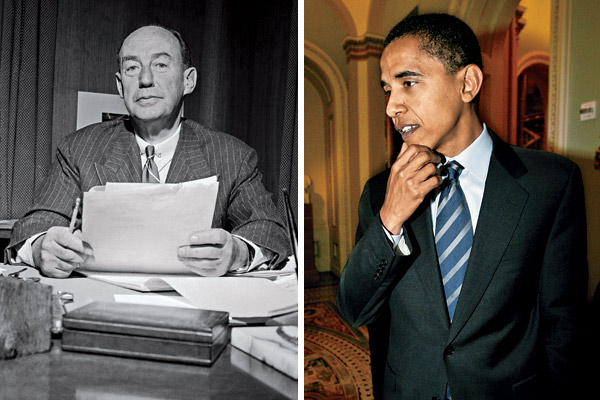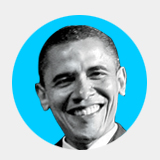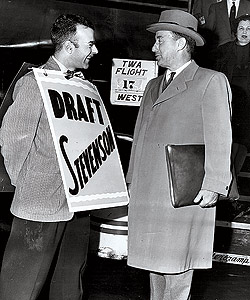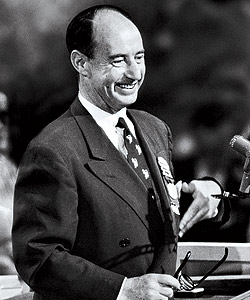
He was a Democratic presidential candidate from Illinois, a celebrated orator and an intellectual running against a military hero at the time of an unpopular war. His political resumé was relatively short, and his appeal formed in part around his call for a change in the practice of politics in this country. Critics claimed he was an elitist, and Republicans accused him of being weak and naïve about America’s enemies. He got crushed in the general election.
A glimpse into the future? No, a snapshot of the past—the 1952 presidential election. Adlai E. Stevenson of Libertyville, the popular governor of Illinois, ran on the Democratic ticket against Dwight D. Eisenhower, the former army general who had been a major architect of the Allied victory in World War II.
So, is the presumptive Democratic candidate, Illinois senator Barack Obama, the second coming of Adlai Stevenson? A number of observers have suggested as much, including (gleefully, one suspects) Karl Rove, the Republican strategist. The answer is no. Gaping differences separate the candidates and their eras. "Actually, Barack is more like Jack Kennedy in that he represents a generational change in the country," says Newton Minow, the Chicago lawyer (and friend of Obama) who worked for both Stevenson and JFK.
Still, the parallels between Stevenson and Obama are pronounced, if easy to exaggerate (see chart). To elaborate just a few:
Both men ignited their national political careers with a stirring speech to a Democratic National Convention. Actually, in Stevenson’s case there were two speeches. In 1952, the Democrats gathered in Chicago at the International Amphitheatre, at Halsted and 43rd Street. Stevenson had not entered a single primary and had insisted he didn’t want to run for president, despite being recruited by the sitting president, Harry Truman. As governor of Illinois, though, Stevenson greeted the delegates on July 21st with a welcoming address that flashed his wit and thoughtful intelligence and led to what amounted to a draft. "Nobody had heard of Adlai except the people of Illinois," recalls Abner Mikva, the former congressman and federal judge, who was a page at the convention. "He just fired up the delegates." Five days later, in accepting the nomination, Stevenson gave a self-deprecating and candid speech that many consider one of the outstanding political orations in U.S. history. "The ordeal of the twentieth century, the bloodiest, most turbulent era of the whole Christian age, is far from over," he proclaimed. "Sacrifice, patience, understanding, and implacable purpose may be our lot for years to come. Let’s face it. Let’s talk sense to the American people. Let’s tell them the truth. . . ." (The speech can be heard here.)
Obama’s introduction to the country beyond Illinois, of course, came with his electrifying keynote at the 2004 Democratic convention in Boston. (Read senior editor David Bernstein’s account of the story behind Obama’s speech.)
Both men fashioned their campaigns in part on calls to improve political life in this country. Stevenson famously sought to turn the campaign into a kind of seminar for voters, insisting that what was important was to educate Americans on the issues. "What does concern me . . . is not just winning this election but how it is won, how well we can take advantage of this great quadrennial opportunity to debate issues sensibly and soberly," he said in his acceptance speech, accurately previewing the style of his campaign.
Obama’s appeal has grown in large part from his promise to lead the country out of a fallow era of bitter partisanship, moving beyond the red-state, blue-state divide, as he eloquently put it in that 2004 keynote.
Critics turned the intelligence and verbal skills of both candidates into a flaw, claiming they were elitist, out of touch with the common man. Based on his family and background, Stevenson certainly counted as upper crust. He came from a well-to-do and distinguished Illinois political family (his grandfather had been vice president under President Grover Cleveland from 1893 to 1897); he had degrees from Princeton and Northwestern University Law School; and he had held several important nonelective government positions. Though he was warm and funny in person, he had a complex intelligence and he refused to speak down to voters. The columnist Stewart Alsop called him an "egghead," and the term caught on. It was not considered a compliment.
Obama’s "elitist" problems have stemmed in part from his thoughtful speaking style, his Ivy League education, his Hyde Park/ University of Chicago roots, his popularity with well-off white liberals, and his difficulty connecting with working-class white voters—all of which he inadvertently spotlighted with his comment in April about the "bitter" residents of small towns.
Newt Minow admires the quality of thinking of both Obama and Stevenson. "They are much alike in the way they look at issues. They are not ideologues—they have the habit of looking at all sides." On the campaign trail, however, where simplicity (if not simple-mindedness) is often rewarded, that professorial style of analysis led to confusion and charges of waffling.
Both men offered a somewhat internationalist, collaborative foreign policy approach—especially compared with the conservative wing of the GOP—and both came under withering criticism for being weak on national defense. Stevenson had participated in the creation of the United Nations in San Francisco in 1945, and he emphasized the importance of working globally throughout his public life, which culminated in a term as ambassador to the UN under Presidents Kennedy and Johnson. In the 1952 campaign, at a time of growing U.S. anxiety over the Soviet threat, Eisenhower’s vice presidential running mate and campaign heavy, Richard Nixon, called Stevenson "Adlai the Appeaser" and accused him of being soft on Communism.
Obama’s internationalist tilt has been featured in his criticism of what he has called the "failed cowboy diplomacy" of the Bush Administration and his stated willingness to talk to hostile leaders, such as the president of Iran. In response, the GOP has consistently painted the Illinois senator as naïve and reckless, and some Republicans have accused him of having a "Sept. 10 mindset."
* * *
|
|
Given the outcome of the 1952 election (Eisenhower collected 55 percent of the popular vote, which understates his whopping 442 to 89 electoral-college victory), shouldn’t a loyal Obama Democrat be suffering nightmares of déjà vu? Let’s look at some of the differences. One candidate was white, 52, and the first single divorced man to run for president. The other is a 47-year-old half-black native of Hawaii, whose wife is active in the campaign. Though both men rightfully won praise for their speaking abilities, they put those talents to quite different uses. Stevenson’s style was low-key, cerebral, even slightly dense by modern media standards. His son Adlai Stevenson III, who supports Obama, pointedly says, "My father’s eloquence was substantive." In her 1996 biography The Stevensons, Jean H. Baker describes how the candidate obsessively wrote and rewrote his speeches, insisting that they be fresh for each audience—a sacrifice of time and energy that she says impeded his campaign. In contrast, Obama has developed a rousing delivery (at least, on selected occasions) that some ascribe to his attendance at African American churches. And though Obama substantially writes many of his own speeches, like every other modern candidate he endlessly recycles his standard stump talks.
When Stevenson first ran, television had only recently launched its invasion of American households, and the ’52 campaign was the first in which the candidates appealed directly to voters through the tube. The parties bought chunks of airtime, and separately Stevenson and Eisenhower talked live to the audience about the issues. There were no televised debates. Again, by Baker’s account, Stevenson’s fastidiousness about his language and his arguments got him in trouble—he often appeared stiff and sour in front of the cameras, and he sometimes misjudged the allotted minutes so that the broadcast got cut off before he had finished. Both he and Eisenhower were wary of the new medium, but Stevenson refused coaching and even makeup. As Baker sums up his attitude: "What Stevenson wanted was the people’s ears and minds, not their eyes or hearts."
The TV ads during the ’52 campaign also suggest (to a modern sensibility, anyway) that the Republicans were far ahead of Democrats in matching the new medium to their candidate. Notable Eisenhower spots show the former commander of Allied forces in Europe forthrightly answering questions from a purported man on the street. The Stevenson ads are mostly cartoons and jingles, the sort of thing used to sell toothpaste or breakfast cereal. (A wonderful Web site, LivingRoomCandidate .org, has collected the major TV ads from campaigns over the years.)
Obama has earned mixed reviews on his television appearances, though he certainly competes well on that front with his presumed Republican opponent, John McCain. More important, though, whereas Stevenson was flummoxed by television, Obama and his team have embraced the new medium of their era, the Internet. As The New York Times recently put it, the campaign has "revolutionized the use of the Web as a political tool, helping the candidate raise more than two million donations of less than $200 each and swiftly mobilize hundreds of thousands of supporters before various primaries." Chris Hughes, one of the founders of the social-networking boom site Facebook, has stepped in as Obama’s "online organizing guru."
Politically, the landscape was utterly different in 1952. When Stevenson ran, the Democrats had held the White House for 20 years, first under Franklin D. Roosevelt, then Harry Truman. "All the baggage that Truman had left—Stevenson had to finesse it," says Paul Green, the Roosevelt University professor of policy studies. That baggage included the unpopular ongoing war in Korea, which had erupted on Truman’s watch. Obama, of course, is running against a two-term Republican administration that initiated the current war in Iraq. In that context, Green points out, Stevenson is more like McCain, having to walk a tightrope between defending his party’s leader and separating from him.
What’s more, as almost everyone concedes today, no one was going to beat Dwight Eisenhower in 1952. Ike returned from World War II a monumental American hero, and both parties tried to recruit him to run for president. (He had started out as a Democrat and later turned Republican, though the isolationist and witch-hunting McCarthyist leanings of the GOP appalled him.) If there was ever any doubt about the outcome of the contest, it was dispelled in October 1952, when Eisenhower vowed if elected to go to Korea. Here was the man given much of the credit for the Allied victory in World War II, promising to take charge of a conflict that baffled and frustrated many Americans.
* * *
People who knew Stevenson or have studied him point to an even more fundamental difference between him and this year’s presumptive Democratic candidate: Stevenson remained deeply ambivalent about running for president. "He did everything he could not to run, including making personal entreaties to Truman," says Adlai Stevenson III. The Guv, as many of his friends called him, believed in the obligation of public service. But the hurly-burly of politics, reaching out to people, building coalitions, bothered him deeply. "Adlai always found it uncomfortable," says Mikva.
His gift for making fun of himself charmed his admirers and many members of the press ("Eggheads of the world, unite!" he famously cried. "You have nothing to lose but your yolks"), but Jean Baker suggests that his humor masked a lack of confidence. "Stevenson wasn’t prepared intellectually, physically, and psychologically for what national politics demands," she told me.
During the campaign, he refused to hedge his positions or pander to his audience—he didn’t "trim, equivocate, or clasp dirty hands," he boasted later to a friend. In his biography, Adlai Stevenson of Illinois, John Bartlow Martin—who served as a Stevenson speechwriter—describes how the candidate seemed to go out of his way to provoke his audience. To the American Legion, he gave a civics lesson on patriotism and its responsibilities; in Michigan, he warned auto workers that he wouldn’t follow a strict labor line; in Harlem, he praised his running mate, John Sparkman, the senator from segregationist Alabama. Stevenson’s "writers learned that the best way to get a point into a speech was to tell Stevenson that his audience would not like it," Jean H. Baker says in her book.
His candor was bracing and perhaps admirable, but it made for difficult politics. Paul F. Boller Jr., the author of Presidential Campaigns, suggests Stevenson was simply naïve about the game. He certainly was idealistic. Adlai III says his father believed the purpose of the campaign was "to inform the public—it didn’t matter who won." Baker put it to me more bluntly: "Stevenson really didn’t care if he was elected to the White House," she said. "He went around the country telling people what they didn’t want to hear."
No one has creditably accused Obama of not caring whether he wins. Indeed, his ambition has contributed to some of his recent campaign dustups, as he has tuned his positions, edged toward the center, and set off accusations of the dreaded flip-flop. What’s more, Obama’s vibrant appeal to new voters and the young far surpasses anything in Stevenson’s flawed campaign.
"Barack loves politics," Newton Minow says, "and Adlai used to say to me, ‘I’m not going to run around shopping centers as if I were running for sheriff.’ He didn’t really like campaigning."
* * *
| SOMETHING IN THE WATER AROUND CHICAGO? | ||
|
The parallels between Stevenson and Obama are intriguing—but don’t get fooled |
 STEVENSON |
 OBAMA |
|
Short political resumé
|
Illinois governor, 1949-53
|
Illinois state senator, 1997-2004; U.S. senator, 2005-
|
|
Ignition to candidacy
|
Speech at 1952 Democratic National Convention
|
Speech at 2004 Democratic National Convention
|
|
Celebrated talent
|
Oration
|
Oration
|
|
Ongoing unpopular war
|
Korea
|
Iraq
|
|
War-hero opponent
|
Dwight D. Eisenhower
|
John McCain
|
|
Chicago clout
|
Jake Arvey (1)
|
Richard M. Daley
|
|
Underlying reformist campaign theme
|
Bring civility to public life
|
End rancorous partisanship
|
|
GOP attack point on national security
|
Communist appeaser
|
Weak on terrorism
|
|
False rumor
|
He’s a homosexual (2)
|
He’s a Muslim
|
|
Disparaging epithet
|
Egghead
|
Elitist
|
|
“Fellow traveler” problem
|
Alger Hiss (3)
|
William Ayers
|
|
(1) From the 1920s to the 1950s, Jake Arvey was a power in Democratic machine politics in Chicago and Cook County, and he slated Stevenson in his 1948 run for governor. (2) Various sources cited by Jean H. Baker in her Stevenson biography link the rumor to the director of the FBI, J. Edgar Hoover, who supported the Republican ticket. (3) Hiss was a former State Department official who was convicted of perjury in 1950 for denying that he had spied for the Soviets. Stevenson had known Hiss since the 1930s when they worked together in Washington, and Stevenson testified for him as a character witness. |
||
But are there lessons for Obama in the Stevenson race? Several people to whom I spoke pointed out that Obama’s tendency—held in common with Stevenson—to turn professorial could cost him votes. Jean Baker says she detects "a slight haughtiness in his speeches and comments. Also, his hesitation in his speeches—as if he’s searching for exactly how to say this in a literate sentence." She wonders if that manner distances him from some people.
Michael Mezey, a professor of political science at DePaul University, who was nine during the ’52 campaign, says his father was a manual laborer who would never have dreamed of voting for a Republican. Yet, once, after a Stevenson speech, Mezey recalls, "I heard my father say to my mother, ‘Either that man is stupid or he thinks I’m stupid.’ You get a little of that with Obama."
Mezey points out that candidates face a conundrum. "Voters say they want an intelligent president, but someone who talks to the people. Obama is trying to navigate that line. He has to find a way to connect with people who are in some ways anti-intellectual." Mezey adds that he thinks Obama recognizes the problem—and he needs only to look back as far as Bill Clinton to find someone who basically solved it.
* * *
On election night in 1952, Stevenson waited at the Governor’s Mansion in Springfield as the returns came in on the radio. He didn’t even carry Illinois. Though he had been ambivalent about taking on the presidency and he put on a good face that night, the results no doubt pained him. John Bartlow Martin recounts that when a woman wearing an Eisenhower pin complimented him for using his campaign to educate the electorate, he responded, "But a lot of people flunked the course." Still, a month later, he was in good humor at a dinner event at the Gridiron Club in Washington, contrasting his overwhelming victory when he ran for governor with his overwhelming defeat going for the presidency: "Did anyone starting from scratch ever enter our public life with such widespread approval, and then leave, with such widespread approval—all in the space of four years?"
Today, as firsthand memories of Stevenson fade, he tends to be invoked mostly as a model in reverse, his name flaunted by conservatives such as Karl Rove and George Will to diminish Barack Obama. In the online magazine Slate, David Greenberg has even argued that Stevenson’s steadfast fans are basically charmed by his role as a lovable loser (a political version of Cubs fever—another Illinois connection). To practitioners of modern, go-for-the-throat politics, Stevenson (who died in 1965) seems gentlemanly, soft, hopelessly un-pragmatic.
Those analyses overlook the passage of time. The 1952 campaign stands as a hinge event between the more issue-oriented campaigns behind and the television-enabled personal politics to come. As Baker argues, Stevenson looked back toward the kind of race that would have been familiar to his grandfather, the vice president. Eisenhower was not a whit more insightful in his understanding of the altered nature of politics, but his oversized heroism fit the new game. "Politics has changed," says Adlai III, himself a former U.S. senator. "The whole process has changed. My father couldn’t do it today."
But it would be wrong for the Obama team to dismiss him or ignore him. In a public career of more than 30 years, Stevenson stood out for his reasoned handling of the issues, highlighted in 1962 by his dramatic denunciation of the Soviets at the United Nations during the Cuban missile crisis. (When the Soviet representative refused to say whether his country was planting missiles in Cuba, Stevenson barked, "I am prepared to wait for my answer until hell freezes over.") While governor, and during his campaigns, he displayed a gift for spotting talent, and many of his colleagues went on to serve in the Kennedy and Johnson administrations. Though he was notably slow to embrace the civil rights movement, his farsighted plans for fighting poverty became cornerstones of the Great Society legislation. He recognized early on the insane dangers—environmental, among them—of the arms race with the Soviets and in the 1956 campaign called for a ban on atmospheric testing of nuclear weapons, a position that was derided by the GOP, but adopted a few years later by President Eisenhower. Long before most other U.S. officials, Stevenson recognized that the conflict in Vietnam was at heart a civil war.
In short, Stevenson had wisdom, integrity, and a keen vision. The Obama people should ask themselves why a candidate can’t have those qualities—and run a strong campaign, too.




